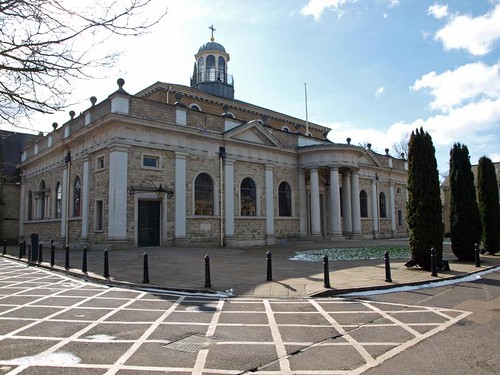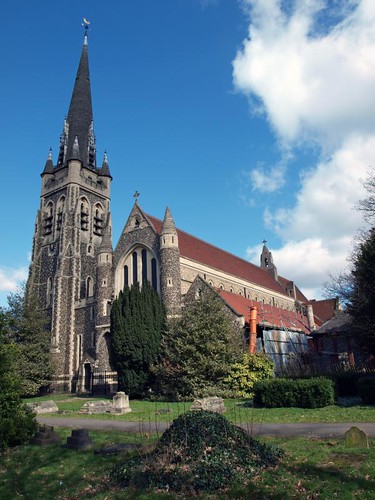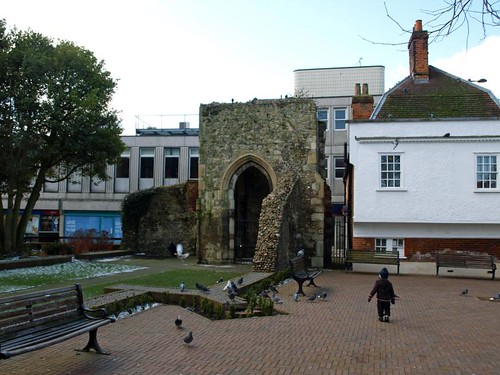They can be summed up thus:
SS Mary & Helen (the Cathedral) - the original 1861 building hideous, the 1989/1991 building splendid.
St Thomas of Canterbury - execrable.
Chapel of Thomas a Becket - an odd survival (in that it was never developed on) and interesting.
ST THOMAS. By E. C. Lee, 1882-90. Large and serious, flint with a tall NW steeple; spire with four spirelets. The interior is E.E., competent but rather dull, but the outside has certain mannerisms which are reminiscent of such a younger man as E. S. Prior. The flints are of pebble size, and the buttresses as well as the stair turret are semicircular in plan. It gives the exterior a curiously primeval flavour.
ST THOMAS'S CHAPEL, High Street. Very little left. Some W and N walling of the nave and the stump of the NW tower. C14. Prettily overgrown with ivy. Brentwood could make better use of this accent in a visually not very successful town.
ROMAN CATHOLIC CATHEDRAL, Ingrave Road. 1861. Ragstone with a polygonal SW turret, of that assertive ugliness which is characteristic of much church work of the sixties. - STAINED GLASS. E window by Mayer of Munich.
Long after Pevsner wrote the above the Cathedral was transformed into something completely different which I think will become, or maybe it already has, a respected piece of architecture:
Brentwood Cathedral began in 1861 as a parish church built in a gothic style.This relatively small building was raised to Cathedral status in 1917. Between 1989 and 1991 the church was enlarged in an Italianate Classical style by Quinlan Terry. The original church building on the south (liturgical east) side was retained.
The new Brentwood Cathedral was dedicated by Cardinal Basil Hume on 31 May 1991. The donors chose to remain anonymous and the money was given solely for this purpose.
Architecturally, Quinlan Terry took his inspiration from the early Italian Renaissance crossed with the English Baroque of Christopher Wren. This, it was felt, would be appropriate for the town and its conservation area, but above all it would provide the right space and light for the liturgy to be celebrated. The cathedral was designed along a square plan, focussed on the high altar, placed in the nave to accommodate the changes in liturgical fashion after the Second Vatican Council.
Work began in 1989 and was completed two years later. The north elevation consists of nine bays each divided by Doric pilasters. This is broken by a huge half-circular portico, which was inspired by a similar one at St Paul's. The handmade traditional Smeed Dean brick of the clerestory leads up to the octagonal lantern, or cupola, the high point both of the outside and inside.
A conscious decision was taken to retain part of the Gothic revival church of 1861 alongside the new classical cathedral. The east elevation juxtaposes the old and the new, linking them through the scale of the 1991 building and the sympathetic use of ragstone and Welsh slate roof tiles.
All the Classical architectural orders are represented in the interior - the four giant Doric pilasters, the Tuscan arcade of arches, the Ionic pilasters of the Palladian windows in the east and west aisles, the Corinthian and Composite influences evident on the cathedral and the organ case.
With clear windows on all four sides, the cathedral is flooded with light at any time of the day. This, together with the white walls and stone floor, combines to give a translucent effect which uplifts the spirit and conveys its own sense of the presence of God. The cathedral is lit by brass English Classical chandeliers (one of which was formerly in the church at Epping) and, above the cornice, concealed lighting.
The processional cross is a copy of a medieval design. The figure represents a transitional period in the theology of design where Christ still wears the crown of the Risen Lord, but the corpus is that of the crucified Saviour. The Bishop's chair or cathedra is a tangible sign of his presiding over the diocese. It was made in Pisa, in Nabrassina stone, and has steps of Portland stone. In the centre is the coat of arms of the diocese. The base of the seat is inlaid with slate, to match the floor.
Consecration crosses are incised into the stone of the Doric pilasters that hold up the clerestory. They were anointed like the altar, as a sign that the whole building is dedicated to God.On the feast of the Dedication the candles in front of the gilded crosses are lit. In the east aisle, there are two rooms set aside to celebrate the Sacrament of Reconciliation or Confession. Opposite them is a crucifix, formerly in the church at Stock, Essex.
Around the arcade are terracotta roundels representing the 15 Stations of the Cross. These were modelled by Raphael Maklouf, the well-known sculptor, who was responsible for the Queen's head on Commonwealth coinage from 1985 to 1997. Their milky glaze perfectly complements the subtlety and intimacy with which the familiar scenes have been expressed.
BRENTWOOD. It has much of the old world still left, and its ancient school has memories of two immortal young Englishmen who gave their lives for England. Long famous as a coaching stage on the Roman road from London, Brentwood has a wide main street, fine old houses, gabled buildings from Tudor England, and attractive inns where there was much coming and going 200 years ago. One of the most interesting has a galleried courtyard with an overhanging upper storey and 500-year-old timbers. Another inn has an Elizabethan roof, and a room with a plaster ceiling panelled and enriched with birds and beasts and men in pleated skirts.
In a garden only a step from the street we come to what is left of Brentwood’s old church, a chapel to Thomas Becket founded by one of the abbots of St Osyth. The lowest storey of its little tower is here, with some fragments of the nave, and the doorways suggest that the masonry still standing is 14th century work. There are two modern churches, one with a tall spire and at its entrance sculptures of Our Lord and the Evangelists, the Wise Virgins, and the martyrdom of Becket; the other (St George’s) a 20th century memorial to an old vicar. It is a striking place and is not yet complete, designed by Mr Laurence King in the spirit of the new movement for making churches appealing to the new generation. It has a spacious sanctuary, processional aisles to the nave, and a lady chapel. Every seat has an unbroken view of the altar. The lighting is indirect and throws no shadows. One of the unusual features of St George’s is an outdoor pulpit at the east end, facing the road; the pulpit has a canopy with a stone crucifix which can be automatically floodlit.
Brentwood is rightly proud of its public school, founded by Sir Anthony Browne in 1557. Its original charter was signed by Philip and Mary on a summer’s day in that year, and the date 1568 is still over the door of the Big School, which remains from the ancient buildings. The fine group of modern buildings stretches from the London Road to Shenfield Common on the outskirts of Brentwood; they include a memorial hall built after the Great War, a spacious 19th century chapel extended in the 20th century, with three aisles, neat open rafters, dignified seats, and an attractive group of lancets in the east window.
Sir Anthony Browne, though he was Queen Mary’s right-hand in the bitter persecution of the Protestants, founded his school to teach “virtue, learning, and manners,” and it would thrill him with pride to know how well his school has fulfilled this high ideal.
It was from Brentwood School that there went out to join the RAF the young airman who wrote to his mother a farewell letter first published in The Times and afterwards in most of the newspapers of the English-speaking World. His name was kept secret, but everybody who read the letter of the unknown airman was deeply moved, and it was felt that it expressed nobly but with great simplicity the feeling of the nation at the time of the Deliverance of Dunkirk, where this young man fell. We are permitted to say that he was a scholar of Brentwood School, where his portrait (by Frank Salisbury) will hang for generations as an example of the character this school is making for our country.
We have no room to give the airman’s letter, written before he set out on the raid from which he did not return, but in it he declared himself lucky to be the right age and fully trained to throw his weight into the scale for England. Those who serve England, he said, must expect nothing from her; we debase ourselves if we regard our country merely as a place in which to eat and sleep. He would have lived and died an Englishman and nothing else mattered. He had no fear of death and would have it no other way:
The universe is so vast and so ageless that the life of one man can only be justified by the measure of his sacrifice. We are sent to this world to acquire a personality and a character to take with us that can never be taken from us.
There is a marble obelisk on a green lawn at the cross-roads in memory of William Hunter, and tradition would have us believe that he was burned to death near the old elm in front of the school. He was a London apprentice in the days of Mary Tudor, and came to live with his father at Brentwood, where, finding a Bible lying on a desk, he learned to read it. They took him to Bishop Bonner for “meddling with the scriptures,” and the bishop, liking him well, offered to make him a freeman in the City and give him £40 to set up a business if he would recant; but he said, “I thank you for your great offer; notwithstanding, my lord, I cannot find in my heart to turn from God for the love of the wor1d.” It was arranged that he should be burned, and on the day of the burning the sheriff's son came to this apprentice boy (who was 19) to bring him comfort, but could speak little for weeping. They brought him a letter from the queen promising him life if he would recant, but William rose and went to the stake, to which he was chained. He cried out, “Son of God shine upon me,” and immediately the sun shone, and the people were much moved as he lifted up his hands in the flames.
Flickr.
In a garden only a step from the street we come to what is left of Brentwood’s old church, a chapel to Thomas Becket founded by one of the abbots of St Osyth. The lowest storey of its little tower is here, with some fragments of the nave, and the doorways suggest that the masonry still standing is 14th century work. There are two modern churches, one with a tall spire and at its entrance sculptures of Our Lord and the Evangelists, the Wise Virgins, and the martyrdom of Becket; the other (St George’s) a 20th century memorial to an old vicar. It is a striking place and is not yet complete, designed by Mr Laurence King in the spirit of the new movement for making churches appealing to the new generation. It has a spacious sanctuary, processional aisles to the nave, and a lady chapel. Every seat has an unbroken view of the altar. The lighting is indirect and throws no shadows. One of the unusual features of St George’s is an outdoor pulpit at the east end, facing the road; the pulpit has a canopy with a stone crucifix which can be automatically floodlit.
Brentwood is rightly proud of its public school, founded by Sir Anthony Browne in 1557. Its original charter was signed by Philip and Mary on a summer’s day in that year, and the date 1568 is still over the door of the Big School, which remains from the ancient buildings. The fine group of modern buildings stretches from the London Road to Shenfield Common on the outskirts of Brentwood; they include a memorial hall built after the Great War, a spacious 19th century chapel extended in the 20th century, with three aisles, neat open rafters, dignified seats, and an attractive group of lancets in the east window.
Sir Anthony Browne, though he was Queen Mary’s right-hand in the bitter persecution of the Protestants, founded his school to teach “virtue, learning, and manners,” and it would thrill him with pride to know how well his school has fulfilled this high ideal.
It was from Brentwood School that there went out to join the RAF the young airman who wrote to his mother a farewell letter first published in The Times and afterwards in most of the newspapers of the English-speaking World. His name was kept secret, but everybody who read the letter of the unknown airman was deeply moved, and it was felt that it expressed nobly but with great simplicity the feeling of the nation at the time of the Deliverance of Dunkirk, where this young man fell. We are permitted to say that he was a scholar of Brentwood School, where his portrait (by Frank Salisbury) will hang for generations as an example of the character this school is making for our country.
We have no room to give the airman’s letter, written before he set out on the raid from which he did not return, but in it he declared himself lucky to be the right age and fully trained to throw his weight into the scale for England. Those who serve England, he said, must expect nothing from her; we debase ourselves if we regard our country merely as a place in which to eat and sleep. He would have lived and died an Englishman and nothing else mattered. He had no fear of death and would have it no other way:
The universe is so vast and so ageless that the life of one man can only be justified by the measure of his sacrifice. We are sent to this world to acquire a personality and a character to take with us that can never be taken from us.
There is a marble obelisk on a green lawn at the cross-roads in memory of William Hunter, and tradition would have us believe that he was burned to death near the old elm in front of the school. He was a London apprentice in the days of Mary Tudor, and came to live with his father at Brentwood, where, finding a Bible lying on a desk, he learned to read it. They took him to Bishop Bonner for “meddling with the scriptures,” and the bishop, liking him well, offered to make him a freeman in the City and give him £40 to set up a business if he would recant; but he said, “I thank you for your great offer; notwithstanding, my lord, I cannot find in my heart to turn from God for the love of the wor1d.” It was arranged that he should be burned, and on the day of the burning the sheriff's son came to this apprentice boy (who was 19) to bring him comfort, but could speak little for weeping. They brought him a letter from the queen promising him life if he would recant, but William rose and went to the stake, to which he was chained. He cried out, “Son of God shine upon me,” and immediately the sun shone, and the people were much moved as he lifted up his hands in the flames.
Flickr.



No comments:
Post a Comment